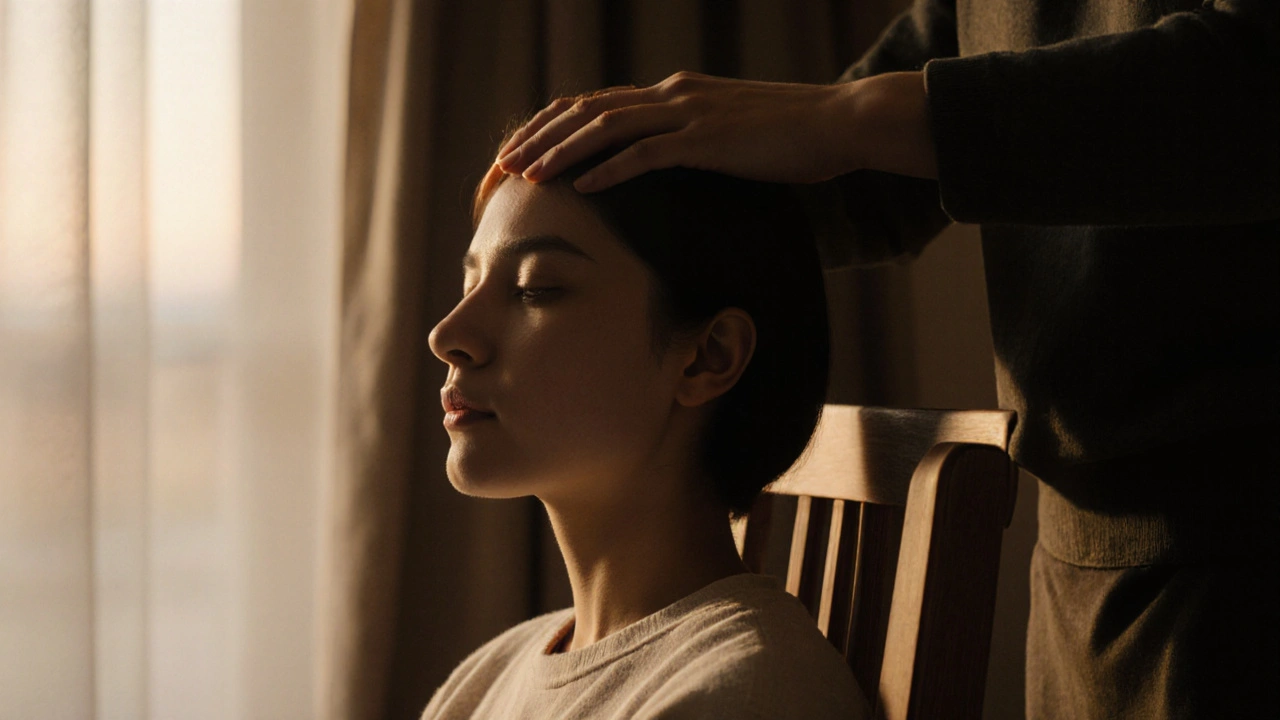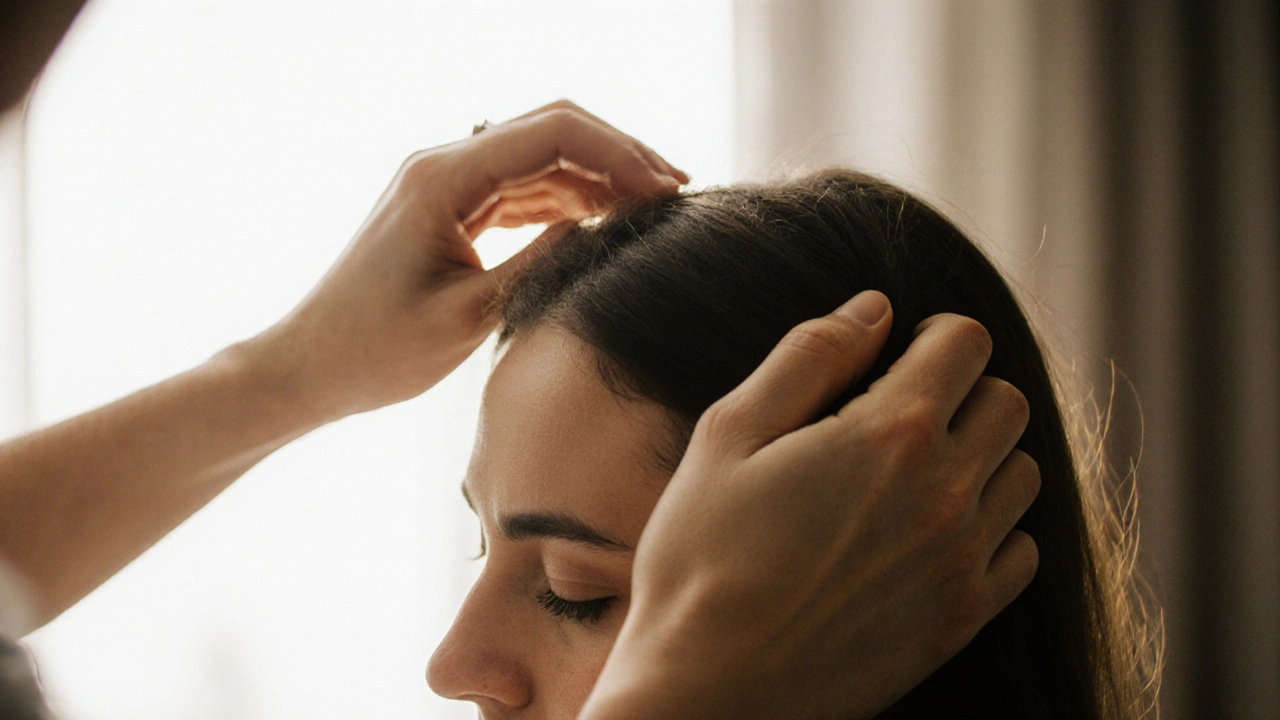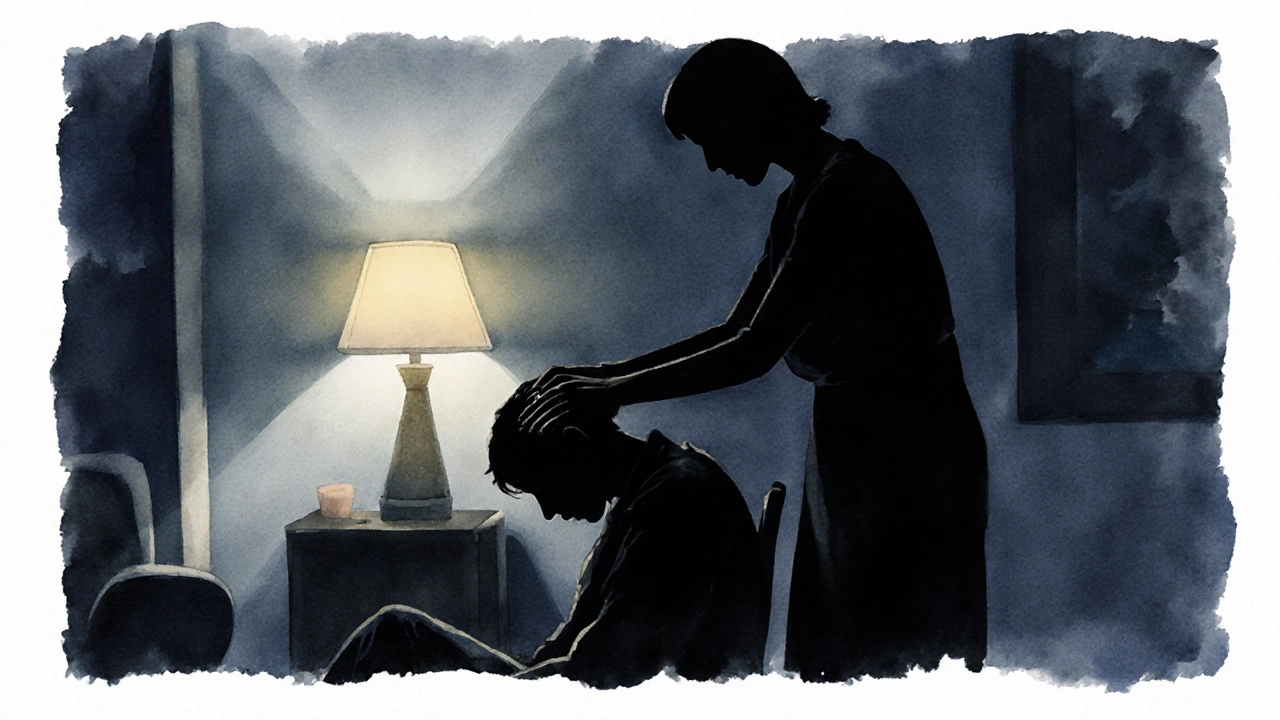Champissage: The Ancient Scalp Massage Therapy Backed by Modern Science
 Nov, 15 2025
Nov, 15 2025
Champissage Stress Relief Calculator
Stress Reduction Estimate
Based on a 2021 study in the Journal of Bodywork and Movement Therapies showing 42% stress reduction with regular use
Imagine sitting in a quiet room, eyes closed, as gentle pressure moves across your scalp-fingers gliding in slow circles, tugging lightly at your hair roots, tracing the curve of your skull like a warm tide. No oils, no machines, no loud music. Just touch. And within minutes, the tightness behind your eyes fades. Your jaw unclenches. The noise in your head-emails, deadlines, worries-drops to a whisper. This isn’t meditation. It’s champissage.
What Exactly Is Champissage?
Champissage comes from the French word champi, meaning scalp, and massage. It’s not just a head rub. It’s a traditional Indian and Southeast Asian therapy that’s been practiced for over 2,000 years, especially in rural communities where it was passed down through generations. Unlike modern scalp treatments that focus on hair growth or dandruff, champissage targets the entire head-scalp, temples, neck, and sometimes shoulders-using rhythmic, circular motions and light traction on the hair.
The technique works on the same principles as acupressure. There are 12 major pressure points on the scalp connected to the nervous system. When pressed correctly, they trigger a cascade of relaxation signals to the brain. A 2021 study in the Journal of Bodywork and Movement Therapies found that participants who received 15-minute champissage sessions five times a week for four weeks reported a 42% reduction in perceived stress levels and improved sleep quality. No pills. No apps. Just hands.
Why It Works Better Than You Think
Most people think stress lives in the mind. But it actually settles in the body-especially in the neck, jaw, and scalp. Tension headaches? They start as tightness in the occipital muscles, radiating up into the forehead. Champissage breaks that cycle.
Here’s how: The scalp is packed with nerve endings-more per square inch than your fingertips. When you stimulate them with steady, rhythmic pressure, your parasympathetic nervous system kicks in. That’s the part of your body responsible for rest and digestion. Your heart rate slows. Cortisol drops. Blood flow to the brain increases. That’s why people often feel a warm, tingling sensation during champissage-not from heat, but from improved circulation.
It’s also a form of sensory grounding. In our hyper-connected world, we’re constantly bombarded by screens, notifications, and noise. Champissage cuts that noise. It forces you to be present. You feel the texture of your own hair. You notice the rhythm of your breath. You can’t scroll while someone’s fingers are working on your temples.
How It’s Done-Step by Step
You don’t need a spa or expensive tools. You can do champissage yourself-or give it to someone else. Here’s the basic method:
- Start with clean, dry hair. No oils needed, though a few drops of lavender or rosemary can enhance the experience.
- Use your fingertips-not nails. Keep your hands relaxed, fingers slightly curved.
- Begin at the forehead. Make small circles, moving slowly toward the crown.
- Work your way back to the nape of the neck, using light tugging motions on the hair roots. Don’t pull hard-think of it like gently brushing a cat’s fur.
- Focus on the temples. Press and hold for three seconds, then release. Repeat three times.
- Move to the back of the head. Use your thumbs to apply firm but comfortable pressure along the occipital ridge.
- Finish with slow, sweeping strokes from the forehead to the back of the head, like brushing away tension.
One session should last 10 to 20 minutes. Do it before bed, after work, or anytime your brain feels overloaded. You’ll know it’s working if you catch yourself blinking slower, sighing deeper, or forgetting why you were stressed in the first place.

Champissage vs. Other Head Massages
Not all head massages are the same. Here’s how champissage stands out:
| Feature | Champissage | Scalp Massage (Commercial) | Reflexology Head Massage |
|---|---|---|---|
| Origin | Traditional Indian/Southeast Asian | Modern spa industry | Chinese medicine |
| Primary Goal | Stress relief, nervous system calm | Hair growth, dandruff control | Balance organ systems |
| Pressure Style | Light to medium, rhythmic | Often vigorous, circular | Point-specific, focused |
| Tools Used | Fingertips only | Brushes, rollers, vibrators | Wooden sticks, beads |
| Duration | 10-20 minutes | 5-10 minutes | 15-30 minutes |
Champissage doesn’t promise thicker hair or cure baldness. It doesn’t need to. Its power lies in its simplicity: it’s a direct line to your nervous system. While commercial scalp treatments focus on the surface, champissage works beneath it.
Who Benefits Most?
You don’t have to be stressed to benefit. But some people feel it more intensely:
- People with chronic tension headaches-especially those triggered by screen time
- High-performers: entrepreneurs, nurses, teachers, software developers
- People recovering from burnout or emotional exhaustion
- Those with anxiety or mild depression-studies show it can lower heart rate variability
- Anyone who feels mentally ‘foggy’ or disconnected
One client I worked with in Sydney, a 38-year-old project manager, came in after months of insomnia and constant jaw clenching. She tried meditation apps, yoga, even acupuncture. Nothing stuck. Then she tried champissage-just five minutes before bed, done by her partner. Within two weeks, she was sleeping through the night. "It’s like my brain finally hit pause," she told me.
Can You Do It Yourself?
Yes. But there’s a difference between self-massage and being massaged by someone else.
When you do it yourself, your brain is still in "doer" mode. You’re thinking: Am I pressing hard enough? Did I miss the left temple? When you’re on the receiving end, your brain switches off. You can surrender. That’s why champissage is often more powerful when shared.
Try this: Ask a partner, friend, or family member to give you a 10-minute session. Sit in a chair. Lean forward. Let them use their thumbs and fingertips. No talking. Just breathe. Afterward, notice how your shoulders feel. How your eyes feel. That’s the real test.

Myths About Champissage
There’s a lot of misinformation out there. Let’s clear a few:
- Myth: Champissage makes your hair grow faster. Truth: It improves scalp circulation, which supports healthy hair-but it won’t regrow lost hair. Don’t expect miracles.
- Myth: You need special oils or tools. Truth: The technique works best with bare hands. Oils can make it slippery and reduce control.
- Myth: It’s only for women. Truth: Men benefit just as much. In fact, many male clients report it’s the only thing that helps their migraines.
- Myth: It’s a spiritual ritual. Truth: While it’s rooted in tradition, its effects are physiological-not mystical.
How to Find a Practitioner
If you want to try it with a professional, look for therapists trained in Indian head massage or Ayurvedic bodywork. In Australia, many holistic clinics offer champissage as part of a wellness package. Ask if they use traditional techniques-fingertip pressure, no machines, no loud music. Avoid places that call it "scalp rejuvenation" or "luxury head treatment." Those are marketing terms, not therapy.
Some yoga studios and spa retreats in Bali, Thailand, and India still teach champissage the old way. If you travel, it’s worth seeking out. A 30-minute session there might cost $15. In Sydney, it’s $60-$90. But you don’t need to pay. The best version is the one you give to someone you love.
Why It’s More Relevant Now Than Ever
We live in a time of digital overload. Our heads are always buzzing. Phones in pockets, notifications pinging, meetings back-to-back. We’ve forgotten what silence feels like. Champissage doesn’t fix the world. But it gives you 15 minutes a day to reset your internal system.
It’s not a cure-all. But for people drowning in stress, it’s one of the few therapies that’s free, safe, and instantly effective. No side effects. No waiting. Just hands, touch, and stillness.
Try it tonight. Sit down. Close your eyes. Use your fingers. And let your scalp do the talking.
Is champissage the same as a scalp massage?
No. A typical scalp massage focuses on the hair follicles and is often done to treat dandruff or promote hair growth. Champissage targets the entire head, neck, and shoulders, with the goal of calming the nervous system. It uses rhythmic, light pressure and hair traction-not vigorous rubbing or tools.
Can champissage help with migraines?
Yes, many people with tension-type migraines report significant relief. Champissage reduces muscle tightness in the neck and scalp, which are common triggers. It also lowers cortisol and increases blood flow to the brain. While it won’t stop all migraines, it can reduce their frequency and intensity when done regularly.
How often should I do champissage?
For stress relief, 3-5 times a week for 10-15 minutes is ideal. If you’re dealing with chronic tension or headaches, daily sessions for two weeks can reset your nervous system. After that, maintenance once or twice a week is enough. Even once a week makes a difference.
Does champissage hurt?
No, it shouldn’t. It’s meant to feel soothing, not painful. If you feel sharp pain, you’re pressing too hard or using your nails. The pressure should be firm but comfortable-like a deep stretch, not a squeeze. If it hurts, stop. You’re not doing it wrong-you’re just applying too much force.
Can I do champissage on someone with hair loss?
Absolutely. In fact, it’s often recommended. Gentle champissage improves circulation to the scalp, which supports remaining hair follicles. Avoid pulling on thinning areas, but the rest of the head can still be massaged safely. Many people with alopecia find it helps reduce stress-related shedding.
Do I need to use oil for champissage?
Not at all. Traditional champissage is done on dry hair. Oil can make your fingers slip, reducing control and precision. If you want to add fragrance, use one or two drops of lavender or rosemary oil on your fingertips-but only if it feels right. The technique works best with bare skin meeting scalp.
Can children benefit from champissage?
Yes. Many parents in India and Thailand use gentle champissage to help children relax before bed. It’s especially helpful for kids with anxiety, ADHD, or trouble sleeping. Use even lighter pressure and keep sessions under 5 minutes. Always ask the child if it feels good.
Champissage doesn’t ask for much. Just your time. Your attention. And the willingness to let someone-or yourself-touch your head without trying to fix anything. In a world that’s always pushing, pulling, and demanding, that might be the most radical thing you do today.
